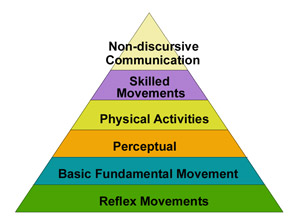Harrow's Taxonomy of Psychomotor Domain
Anita Harrow's taxonomy for the psychomotor domain is organized according to the degree of coordination including involuntary responses as well as learned capabilities. Simple reflexes begin at the lowest level of the taxonomy, while complex neuromuscular coordination make up the highest levels (Seels & Glasgow, 1990).
 Reflex
movements are actions elicited without learning in response to some
stimuli. Examples include: flexion, extension, stretch, postural adjustments.
Reflex
movements are actions elicited without learning in response to some
stimuli. Examples include: flexion, extension, stretch, postural adjustments.
Basic fundamental movement are inherent movement patterns which are formed by combining of reflex movements and are the basis for complex skilled movements. Examples are: walking, running, pushing, twisting, gripping, grasping, manipulating.
Perceptual refers to interpretation of various stimuli that enable one to make adjustments to the environment. Visual, auditory, kinesthetic, or tactile discrimination. Suggests cognitive as well as psychomotor behavior. Examples include: coordinated movements such as jumping rope, punting, or catching.
Physical activities require endurance, strength, vigor, and agility which produces a sound, efficiently functioning body. Examples are: all activities which require a) strenuous effort for long periods of time; b) muscular exertion; c) a quick, wide range of motion at the hip joints; and d) quick, precise movements.
Skilled movements are the result of the acquisition of a degree of efficiency when performing a complex task. Examples are: all skilled activities obvious in sports, recreation, and dance.
Non-discursive communication is communication through bodily movements ranging from facial expressions through sophisticated choreographics. Examples include: body postures, gestures, and facial expressions efficiently executed in skilled dance movement and choreographics.
Harrow, A.J. (1972). A taxonomy of the psychomotor domain. New York: David McKay Co.
Seels and Glasgow (1990). Exercises in instructional design. Columbus OH: Merrill Publishing Company.